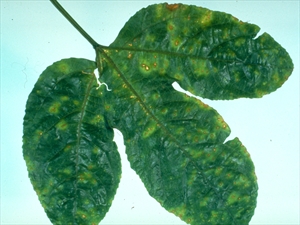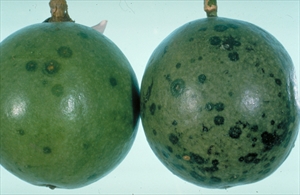Brown spot and Alternata spot
Pacific Pests, Pathogens and Weeds - Online edition
Pacific Pests, Pathogens & Weeds
Passionfruit spots (153)
Alternaria passiflorae (brown spot) and Alternaria alternata (Alternata spot).
Alternaria passiflorae is recorded from Australia, Fiji, New Caledonia, New Zealand, Niue, Papua New Guinea, and Tonga. Alternaria alternata is reported from Australia, Niue, Samoa, and Vanuatu.
Passionfruit, granadilla and weed relatives (e.g., stinking passion flower, Passiflora foetida).
Symptoms of both species are similar and it would be difficult to tell them apart without microscopic examination of the fungi involved.
On the leaves, the spots are 6-10 mm wide, brown at first, becoming light brown later. Yellow haloes surround the spots of Alternaria alternata (Photo 1). Leaves fall after developing only a few spots. Spots also occur on the stems; those of Alternaria passiflorae are larger, up to 30 mm, and sometimes girdle and kill the stems (Photo 2). Stem spots of Alternaria alternata rarely kill the stems.
Similar symptoms occur on granadilla (Photo 3).
On the fruits, the spots start as tiny greyish spots, and then become light brown, and finally dark brown (Photo 4), with wrinkled, sunken centres (Alternaria alternata), usually less than 10 mm diameter. Spots of Alternaria alternata are generally larger, and may cover one side of the fruit.
Spores produced on the fruit, leaves and stems are spread in wind and rain.
Two fungi are the cause of these two closely related diseases. They are especially severe in warm, wet weather. In Samoa, it is estimated that losses from Alternaria alternata can reach 30% in the higher areas where the crop is grown. There are, however, differences between varieties in their resistance to the disease. Spots less than 10 mm on the fruits can still be used for juice, but, if more than that, the fruits usually have internal rots and cannot be processed.
Alternaria alternata and Alternaria passiflorae are both serious diseases in Australia. They can cause significant loss of yield due to leaf damage, and in the case of infection by Alternaria alternata, damage to the fruit, so that it is only fit for processing.
Look for brown spots with light centres on the fruit, leaves and stem. Look for the wrinkled spots on the fruits; those of Alternaria passiflorae are sunken, rotting the flesh beneath the skin.
CULTURAL CONTROL
Cultural control is particularly important in the management of this disease:
- Spacing: Allow space between rows of plants so that air can circulate and dry leaves quickly after rain.
- Nutrition: Ensure that plants have sufficient manure or fertilizer for good health.
- Pruning: Prune vines to remove dead and weak sections; this will allow better air circulation and penetration of fungicide, if used.
- Weeds: Wild species of passionfruit are susceptible, and a source of spores. Remove white passion flower (Passiflora subpeltata), and stinking passion flower (Passiflora foetida) if these are growing nearby.
- Hygiene: After pruning, collect the debris and burn it. Note, the fungus can remain alive in the soil between fruiting seasons.
RESISTANT VARIETIES
Yellow passionfruit is tolerant, but purple passion fruit and hybrids between purple and yellow are very susceptible.
CHEMICAL CONTROL
Where these diseases are present, in countries that are hot and have high rainfall, chemical control may be required to obtain an acceptable crop. If fungicides are needed, use sprays of copper or mancozeb.
____________________
When using a pesticide, always wear protective clothing and follow the instructions on the product label, such as dosage, timing of application, and pre-harvest interval. Recommendations will vary with the crop and system of cultivation. Expert advice on the most appropriate pesticide to use should always be sought from local agricultural authorities.
AUTHOR Grahame Jackson
Information from Gerlach WWP (1988) Plant diseases of Western Samoa. Samoan German Crop Protection Project, Deutsche Gesellschaft für Technische Zusammenarbeit (GTZ) Gmbh, Germany; and from (including Photos 1,2&4) Diseases of fruit crops in Australia (2009). Editors, Tony Cooke, et al. CSIRO Publishing. Photo 3 Kohler F, et al. (1997) Diseases of cultivated crops in Pacific Island countries. South Pacific Commission. Pirie Printers Pty Limited, Canberra, Australia.
Produced with support from the Australian Centre for International Agricultural Research under project PC/2010/090: Strengthening integrated crop management research in the Pacific Islands in support of sustainable intensification of high-value crop production, implemented by the University of Queensland and the Secretariat of the Pacific Community.







